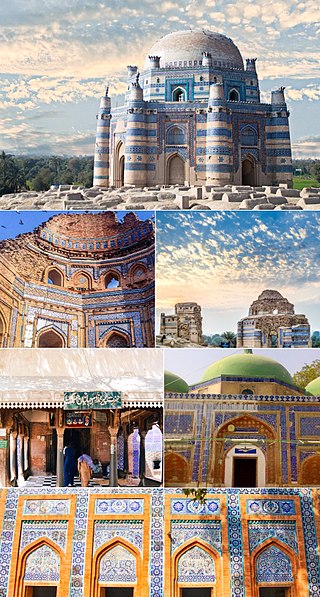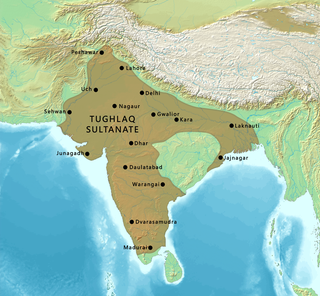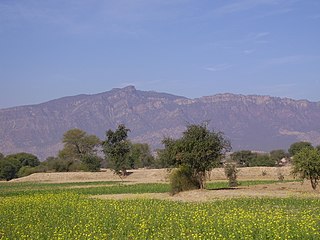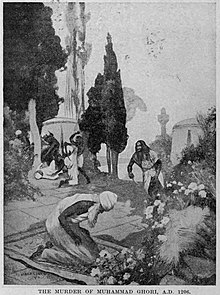
Punjab, also known as the Land of the Five Rivers, is a geopolitical, cultural, and historical region in South Asia. It is specifically located in the northwestern part of the Indian subcontinent, comprising areas of modern-day eastern-Pakistan and northwestern-India. Punjab's major cities are Lahore, Faisalabad, Rawalpindi, Gujranwala, Multan, Ludhiana, Amritsar, Sialkot, Chandigarh, Shimla, Jalandhar, Patiala, Gurugram, and Bahawalpur.

Punjab is a province of Pakistan. Located in central-eastern region of the country, Punjab is the second-largest province of Pakistan by land area and the largest by population. Lahore is the capital and the largest city of the province. Other major cities include Faisalabad, Rawalpindi, Gujranwala and Multan.

The Delhi Sultanate or the Sultanate of Delhi was a late medieval empire primarily based in Delhi that stretched over large parts of the Indian subcontinent, for 320 years (1206–1526). Following the invasion of South Asia by the Ghurid dynasty, five dynasties ruled over the Delhi Sultanate sequentially: the Mamluk dynasty (1206–1290), the Khalji dynasty (1290–1320), the Tughlaq dynasty (1320–1414), the Sayyid dynasty (1414–1451), and the Lodi dynasty (1451–1526). It covered large swaths of territory in modern-day India, Pakistan, and Bangladesh as well as some parts of southern Nepal.

Multan is a city in Punjab, Pakistan, located on the bank of river Chenab. It is one of the five largest urban centres of Pakistan in 2024 and serves as the administrative centre of Multan Division. A major cultural, religious and economic centre of Punjab region, Multan is one of the oldest inhabited cities of Asia, with a history stretching deep into antiquity.

The History of Punjab refers to the past history of Punjab region which is a geopolitical, cultural, and historical region in the northwest of South Asia, comprising eastern Punjab province in Pakistan and western Punjab state in India. It is believed that the earliest evidence of human habitation in Punjab traces to the Soan valley of the Pothohar, between the Indus and the Jhelum rivers, where Soanian culture developed between 774,000 BC and 11,700 BC. This period goes back to the first interglacial period in the second Ice Age, from which remnants of stone and flint tools have been found.
The Sayyid dynasty was the fourth dynasty of the Delhi Sultanate, with four rulers ruling from 1414 to 1451 for 37 years. The first ruler of the dynasty, Khizr Khan, who was the Timurid vassal of Multan, conquered Delhi in 1414, while the rulers proclaimed themselves the Sultans of the Delhi Sultanate under Mubarak Shah, which succeeded the Tughlaq dynasty and ruled the Sultanate until they were displaced by the Lodi dynasty in 1451.

Uch, frequently referred to as Uch Sharīf, is a historic city in the southern part of Pakistan's Punjab province. Uch may have been founded as Alexandria on the Indus, a town founded by Alexander the Great during his invasion of the Indus Valley. Uch was an early stronghold of the Delhi Sultanate during the Muslim conquest of the subcontinent. It is also known as the home for the Naqvi/Bukhari's after the migration from Bukhara. Uch was a regional metropolitan centre between the 12th and 17th centuries, and became refuge for Muslim religious scholars fleeing persecution from other lands. Though Uch is now a relatively small city, it is renowned for its intact historic urban fabric, and for its collection of shrines dedicated to Muslim mystics (Sufis) from 12th-15th centuries that are embellished with extensive tile work, and were built in the distinct architectural style of southern Punjab.

The Tughlaq dynasty was the third dynasty to rule over the Delhi sultanate in medieval India. Its reign started in 1320 in Delhi when Ghazi Malik assumed the throne under the title of Ghiyath al-Din Tughluq. The dynasty ended in 1413.
The Gakhar is a historical Punjabi Muslim tribe with origins in the northern Punjab, Pakistan. The Gakhars now predominantly follow Islam after conversion from Hinduism during the Islamic rule in Punjab.
Muslim Rajputs or Musalman Rajpoots are the descendants of Rajputs in the northern regions of the Indian subcontinent who generally are followers of Islam. Reportedly, they converted from Hinduism to Islam from the medieval period onwards, creating various dynasties and states while retaining Hindu surnames such as Chauhan. Today, Muslim Rajputs can be found mostly in present-day Northern India and Pakistan. They are further divided into different clans.
The recorded history of Lahore, the second largest city-district of Pakistan, covers thousands of years. Lahore is regarded as the post medieval or modern day capital and largest city of the Punjab region, it has since its creation changed hands from Ghaznavid, Hindu, Buddhist, Greek, Muslim, Mughal, Ghorid, Maratha, Sikh and the British, thereby becoming the cultural capital and the heart of modern-day Pakistan.

Pakpattan, often referred to as Pākpattan Sharīf, is the capital city of the Pakpattan District, located in Punjab province of Pakistan. It is the 48th largest city of Pakistan by population according to the 2017 census. Pakpattan is the seat of Sufi Chisti order in Pakistan, and a major pilgrimage destination on account of the Shrine of Baba Farid, a renowned Punjabi poet and Sufi saint. The annual urs fair in his honour draws an estimated 2 million visitors to the town.

Khizr Khan was the founder of the Sayyid dynasty, the fourth ruling dynasty of the Delhi sultanate, in northern India soon after the invasion of Timur and the fall of the Tughlaq dynasty. Khizr Khan was Governor of Multan under the Tughlaq ruler, Firuz Shah Tughlaq, and was known to be an able administrator. He did not take up any royal title due to fear of invasion by Amir Timur and contended himself with the titles of Rayat-i-Ala and Masnad-i-Aali or. During his reign, coins were continued to be struck in the name of previous Tughlaq rulers. After his death on 20 May 1421, he was succeeded by his son Mubarak Khan, who took the title of Muizz-ud-Din Mubarak Shah.
Multan in Punjab province of Pakistan is one of the oldest cities of South Asia, though its exact age has yet to be determined. Multan is known for its rich ancient heritage and historic landmarks. Multan was the capital and largest city of Punjab region in late ancient and most of the medieval era. Multan region was centre of many civilizations in its 5 millenia old history, and witnessed warfare across millennia because of its location on a major invasion route between South and Central Asia.

The Pothohar Plateau is a plateau and historical sub-region in northern parts of the Punjab region, present-day Punjab, Pakistan. Ethnic Punjabis are the native people of the area and are subdivided into many tribes and clans (Baradari).

Nasir-ud-Din Mahmud Shah Tughluq, also known as Nasiruddin Mohammad Shah, was the last sultan of the Tughlaq dynasty to rule the Islamic Delhi Sultanate.
Punjabi Muslims are Punjabis who are adherents of Islam. With a population of more than 112 million, they are the third-largest predominantly Islam-adhering Muslim ethnicity in the world, after Arabs and Bengalis.
Jasrat was a 15th-century Punjabi Muslim ruler of Sialkot from 1410 until his death in 1442.
The Battle of Jhelum (1206) was fought in the early 1206 on the bank of river Jhelum in the present-day Pakistan. It was fought between the rebel Khokhars led by Sarkha and the Ghurid forces led by Muhammad of Ghor. The Ghurids won the battle decisively and thus quelled the Khokhar insurrection in the Salt Range.












